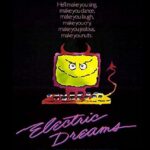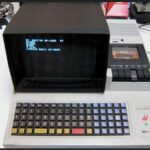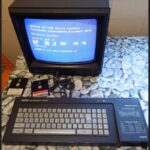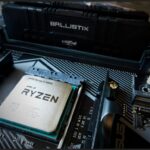 Those of a technophobic disposition should probably look away now.
Those of a technophobic disposition should probably look away now.
As with so many others at the time, my very first programmable computer was the ZX81 from Sinclair.
I can remember the stir caused by its predessor, the ZX80, which had me excited to get one, and when I did, in 1981, I wasn’t disappointed. This was all so new and exciting and opened up so many possibilities for someone with a technical bent, like myself. The ZX81 itself, though pioneering, was a limited machine, especially with its very limiting 1k of memory. It wasn’t long before add-ons came out – one of the most useful of which was a 16K RAM pack that plugged into the rear of the computer. This made a big difference, as it allowed larger and more useful programs to be run on the machine.  However, it was also very infuriating, as the edge connector wasn’t the best at making contact and the slightest knock or wobble would cause it to lose everything. Hours of painstaking typing on that ridiculous membrane keyboard could be lost in a split-second if you weren’t careful. I purchased a proper keyboard for mine – made by Maplin (RIP), I think – which was so much better. I then took the computer apart and rebuilt it into a project box – also procured from Maplin – fixing the RAM pack directly onto the board to eradicate the wobble problem and fitting the power supply inside. I then had to fit a small fan to the top, as I found it would get quite hot. I learnt a quite a bit from playing with that machine.
However, it was also very infuriating, as the edge connector wasn’t the best at making contact and the slightest knock or wobble would cause it to lose everything. Hours of painstaking typing on that ridiculous membrane keyboard could be lost in a split-second if you weren’t careful. I purchased a proper keyboard for mine – made by Maplin (RIP), I think – which was so much better. I then took the computer apart and rebuilt it into a project box – also procured from Maplin – fixing the RAM pack directly onto the board to eradicate the wobble problem and fitting the power supply inside. I then had to fit a small fan to the top, as I found it would get quite hot. I learnt a quite a bit from playing with that machine.
 Inspired by Sinclair’s success in the field, it wasn’t long before other manufacturers started to flood the marketplace with their own machines. My next purchase was a Sharp MZ80K, Which I bought from Lasky’s (RIP) and which had a proper keyboard (well, almost) and a built-in monitor and also a built-in cassette deck for saving and loading up programs. With its huge 48KB of RAM, it was a big step up from the ZX81. I think it was possible to run programs in Pascal on the MZ, but having cut my teeth on BASIC, I struggled to learn it. However, it didn’t hold me back as I became quite a whizz with BASIC and would write some fairly impressive stuff… if I do say so myself. I spents hundreds of hours glued to that machine – sometimes even taking sick days from work, just so I could finish writing a program. It became quite an obsession.
Inspired by Sinclair’s success in the field, it wasn’t long before other manufacturers started to flood the marketplace with their own machines. My next purchase was a Sharp MZ80K, Which I bought from Lasky’s (RIP) and which had a proper keyboard (well, almost) and a built-in monitor and also a built-in cassette deck for saving and loading up programs. With its huge 48KB of RAM, it was a big step up from the ZX81. I think it was possible to run programs in Pascal on the MZ, but having cut my teeth on BASIC, I struggled to learn it. However, it didn’t hold me back as I became quite a whizz with BASIC and would write some fairly impressive stuff… if I do say so myself. I spents hundreds of hours glued to that machine – sometimes even taking sick days from work, just so I could finish writing a program. It became quite an obsession.
 The BBC Micro was quite ubiquitous by now, but for some reason I bypassed it completely… maybe I didn’t want to switch from the Z80 processor that I had been using so far? I don’t know. Anyway, next along for me – and sticking with that same processor – was the Amstrad CPC6128: a colour machine with a whopping 128KB of memory and – more importantly – a built-in floppy disk drive. Oh yeah! Loading and saving to tape was slow and laborious, so again, this was another seachange. This had a better keyboard than the old Sharp and the disk drive was a joy to use in comparison to the old cassette tape. As such, I spent even more hours seated in front of this, than I did with the MZ. This machine introduced me to Word Processing, via a program called Protext that I had on a selectable ROM and an Epson FX80 dot matrix printer which used tractor-fed fan-fold paper. It was bloody brilliant… for those days. The CPC6128 was the last complete desktop computer I ever bought.
The BBC Micro was quite ubiquitous by now, but for some reason I bypassed it completely… maybe I didn’t want to switch from the Z80 processor that I had been using so far? I don’t know. Anyway, next along for me – and sticking with that same processor – was the Amstrad CPC6128: a colour machine with a whopping 128KB of memory and – more importantly – a built-in floppy disk drive. Oh yeah! Loading and saving to tape was slow and laborious, so again, this was another seachange. This had a better keyboard than the old Sharp and the disk drive was a joy to use in comparison to the old cassette tape. As such, I spent even more hours seated in front of this, than I did with the MZ. This machine introduced me to Word Processing, via a program called Protext that I had on a selectable ROM and an Epson FX80 dot matrix printer which used tractor-fed fan-fold paper. It was bloody brilliant… for those days. The CPC6128 was the last complete desktop computer I ever bought.
 In the second half of the 80’s, the Personal Computer (PC) was becoming the standard and I thought I’d have a crack at building one. I’d read about what was involved in one of the computer magazines of the day – and weren’t there some computer magazines back then? Hundreds of different titles. Our local WH Smiths barely had room to stock anything else. Anyway, by phoning the proprietors of various adverts in these magazines (there was no real ‘online’ yet) I ordered all the bits to build an AT 286… what was commonly known back then as an IBM Clone. I remember receiving the Hard Drive in the post: a secondhand Amstrad 20MB unit. Twenty Meg! That was huge! I’d never be able to fill that up! It took me an evening to figure it out and put it all together, but it worked first time. Once again, the speed and the convenience over what I’d had before, was a revelation. And I just loved the 5¼ floppy drive. A ‘proper’ floppy!
In the second half of the 80’s, the Personal Computer (PC) was becoming the standard and I thought I’d have a crack at building one. I’d read about what was involved in one of the computer magazines of the day – and weren’t there some computer magazines back then? Hundreds of different titles. Our local WH Smiths barely had room to stock anything else. Anyway, by phoning the proprietors of various adverts in these magazines (there was no real ‘online’ yet) I ordered all the bits to build an AT 286… what was commonly known back then as an IBM Clone. I remember receiving the Hard Drive in the post: a secondhand Amstrad 20MB unit. Twenty Meg! That was huge! I’d never be able to fill that up! It took me an evening to figure it out and put it all together, but it worked first time. Once again, the speed and the convenience over what I’d had before, was a revelation. And I just loved the 5¼ floppy drive. A ‘proper’ floppy!
From then on, it has all just been a series of upgrades: 286 to 386; 386 to 486; 486 to Pentium, etc, etc. All housed within the same desktop case, so they all looked exactly the same, but each came with a performance improvement.
And then I switched to AMD processors and haven’t looked back: more bang for your buck.
 My current desktop (in a newer and bigger case) runs an AMD Ryzen 5 with 6 cores; 16Gb of RAM and a 1TB Solid State Drive. She fair flies along and has four external USB drives permanently plugged into her, as well as a NAS drive; an inkjet printer; a laser printer/scanner; an SDRPlay RSP and a Kenwood TS-590 HF radio tranceiver.
My current desktop (in a newer and bigger case) runs an AMD Ryzen 5 with 6 cores; 16Gb of RAM and a 1TB Solid State Drive. She fair flies along and has four external USB drives permanently plugged into her, as well as a NAS drive; an inkjet printer; a laser printer/scanner; an SDRPlay RSP and a Kenwood TS-590 HF radio tranceiver.
I currently have no need to upgrade, but with 16-core processors now on the market, and large SSD drives getting cheaper all the time, it probably won’t be too long before I get out the screwdrivers and the thermal paste.
Never mind all the technical gubbins. I just miss Maplins. What a terrific shop that was. I’m still very sad it’s no longer with us. Anyway. My first PC put on my desk at work was an ICL DRS M30 (http://www.vintage-icl-computers.com/icl32). 20Mb HD that clanked like a knight in a suit of armour, and stunning 256k RAM. It would run Supercalc and Wordperfect but not at the same time.
Maplins were brilliant when they were just an electronic component supplier. Ordering components from a huge catalogue, over the phone and having them arrive a few days later was a revelation in those days. But they expanded and opened shops and tried to appeal to a wider customer base, by increasing their range to all sorts of tat. Costs of their components raised accordingly and the electronics enthusiast community voted with their feet. That was part of Maplin’s downfall, I reckon.
I loved Wordperfect.
At the time.
They still exist online. But it’s no substitute for going in to the store and browsing and picking stuff up and thinking ‘I could probably use this…’
What a well catalogued journey of computing.. Mark if you remembered some of the pricing for them
The only price I can remember, Rajesh, is when – after work, one evening – I drove all the way down to Swiss Cottage, to purchase 2GB of RAM for 150 quid… a bargain at the time.
Crazy, seems unbelievable, inflation adjusted may be you can get 5-10 TB now..such a long way in such a short span of time
Hi Mate, what software are you using for the SDRPlay?
I use either SDR Uno on a Win10 machine or GQRX on the Linux box (Ubuntu 18.04)
Much prefer using GQRX for general listening. No whistles and bells. SDR Uno is to glitzy and complicated but I still use it for sometimes when GQRX doesn’t quite hit the mark. (No pun intended).
Hi Ian. Long time. How’re ya doin’?
I use SDRUno now… although it took me a while to get to grips with it. Still struggle with some bits.
Before that, I was using SDR Console, which I thought was excellent and, in some ways, I prefer it. But, I’ve commited myself to Uno now.
Don’t run Linux anymore, so not heard of GQRX.
The SDRPlay is an excellent bit of kit though, isn’t it?
I’m well thanks.
The SDR Play is a brilliant piece of kit, I just have the 1a but I would say it matches the receiver on my trusty FT-857. I tried SDR Console a few years ago but didn’t really get on with it. If you have got an old desktop laying around, stick a Linux distro on it and give GQRX a whirl. (Don’t use a laptop unless the battery is really good, if the charger is plugged in they make to much QRM) I find it much quicker to use for casual listening than Uno but definitely not a replacement.
If I knew how to do a thumbs-up emoji on here, I would.
👍🤣
Annoyed emoji!